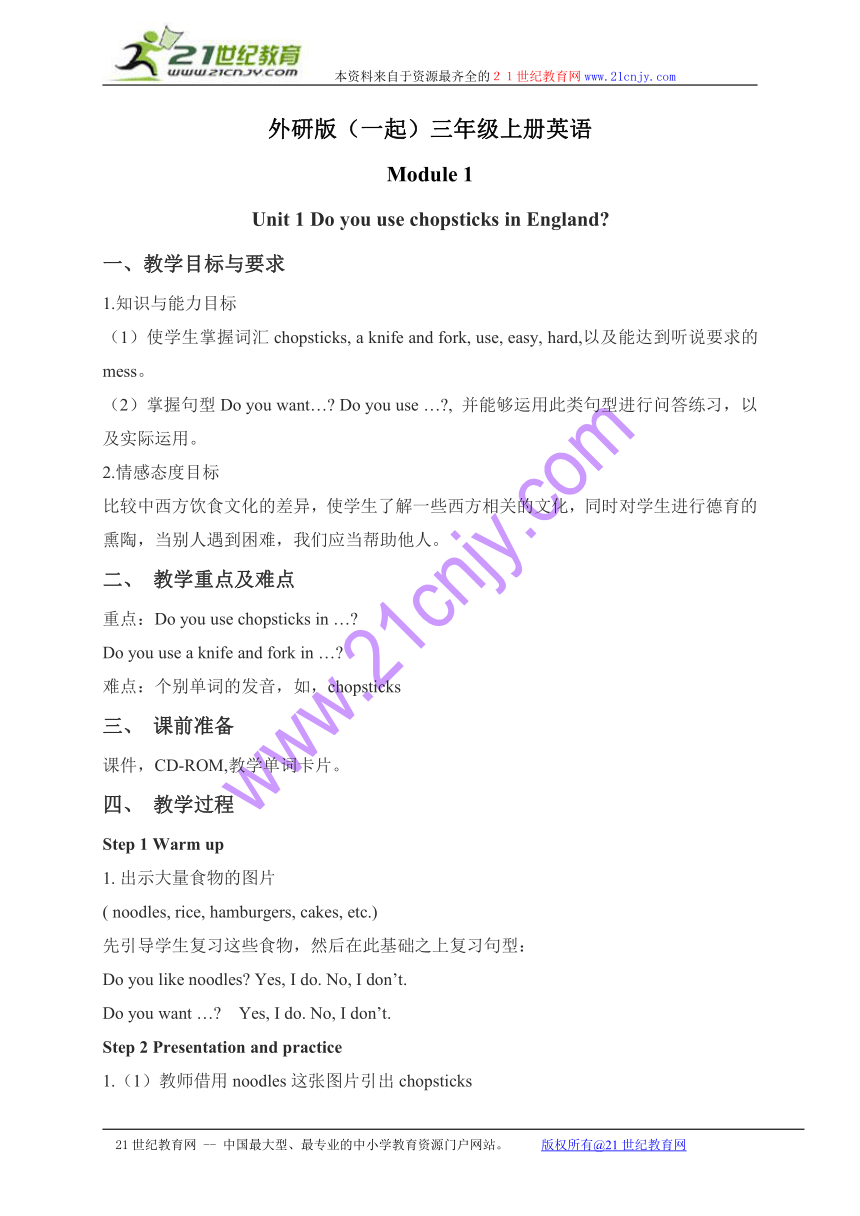外研版(一起)三年级英语上册教案 module 1 unit 1(1)
文档属性
| 名称 | 外研版(一起)三年级英语上册教案 module 1 unit 1(1) |  | |
| 格式 | doc | ||
| 文件大小 | 42.0KB | ||
| 资源类型 | 教案 | ||
| 版本资源 | 外研版(一年级起点) | ||
| 科目 | 英语 | ||
| 更新时间 | 2009-11-26 16:01:00 | ||
图片预览


文档简介
本资料来自于资源最齐全的21世纪教育网www.21cnjy.com
外研版(一起)三年级上册英语
Module 1
Unit 1 Do you use chopsticks in England
一、教学目标与要求
1.知识与能力目标
(1)使学生掌握词汇chopsticks, a knife and fork, use, easy, hard,以及能达到听说要求的mess。
(2)掌握句型Do you want… Do you use … , 并能够运用此类句型进行问答练习,以及实际运用。
2.情感态度目标
比较中西方饮食文化的差异,使学生了解一些西方相关的文化,同时对学生进行德育的熏陶,当别人遇到困难,我们应当帮助他人。
二、 教学重点及难点
重点:Do you use chopsticks in …
Do you use a knife and fork in …
难点:个别单词的发音,如,chopsticks
三、 课前准备
课件,CD-ROM,教学单词卡片。
四、 教学过程
Step 1 Warm up
1. 出示大量食物的图片
( noodles, rice, hamburgers, cakes, etc.)
先引导学生复习这些食物,然后在此基础之上复习句型:
Do you like noodles Yes, I do. No, I don’t.
Do you want … Yes, I do. No, I don’t.
Step 2 Presentation and practice
1.(1)教师借用noodles这张图片引出chopsticks
T: I like noodles. I eat noodles with chopsticks. 拿出实物“筷子”,边做动作边说
chopsticks 引出单词并出示卡片。
小活动:一口气说单词。Let’s have a look who can read more words.
这个单词的读音对于学生来说是一个难点,因而要让学生尽可能多说,及时纠正学生的发音。
(2)教师在与学生的交流中引出新单词use
T: Can you use chopsticks
use 出示卡片
We use chopsticks in China. 引导学生跟随老师自然的说出句型
并且板书,We use chopsticks.
Do you use chopsticks Yes, we do. No, we don’t.并且板书
Ask and answer in pairs.
2. 教师通过询问在英国,人们是否使用筷子,引出a knife and fork,并出示卡片,教读单词
T: We use chopsticks in China. Do the English people use chopsticks
S: No, they don’t.
English people use a knife and fork.
引出a knife and fork,并教读。
补充板书,并且进行简单句型操练,再进行一般疑问句的问答练习:Do you use chopsticks / a knife and fork Yes, I do. No, I don’t.
3. Presentation of the text.
(1) Amy and Daming are in the park. They want to eat noodles. Watch the CD-ROM, then answer the questions: “Does Amy use chopsticks in England ”
第一次观看CD-ROM,并回答问题
(2)再次观看课文Now Amy is using chopsticks. Watch again, then answer the next question: Are the chopsticks “easy” or “hard” for her
easy – hard 引出两个新单词,并引导学生说出完整的句子
Chopsticks are hard for Amy.
A knife and fork are easy for her.
课件出示学生过去学习过的反义词,可先让学生来试着说说看:
big-small long-short fat-thin hot-cold white-black easy-hard
Listen again, then answer: Are the chopsticks “easy” or “hard” for English people
进行小活动:快速说出所出示单词的反义词
T: If I say “big”. You should say “small”. Please say the words as quickly as you can.
Chopsticks are hard for English people. So Amy make the mess.
mess /e/ 出示卡片教读,二会单词
(3) 第三遍打开课本跟读。
(4) Find the sentences, “ Do you … ”. Then circle them.学生领读找出来的句子。
4. Practice
根据课文内容补全句子,分两步由学生补充完整。
(1) In China, we use __________. In England, people use ________.
Chopsticks are ________ for Chinese people. They are _______ for English people.
(2) In …, we use … In …, people use …
… is / are easy for … … is / are hard for …
5. Chant:
Do you use chopsticks Yes I do. Yes, I do.
We use chopsticks in China.
They’re easy for us.
通过课件,学生跟随老师有节奏地表演Chant,同时运用课件给出结构,学生编第二首Chant
Do you use ___________ Yes I do. Yes, I do.
We use ________ in England.
They’re easy for us.
Step 3 Consolidation and extension
1. Activity Book
Page 2 Exercise 1 Look and write the missing words.
2. Guessing Game
(1)运用课件打出第3页练习3的图片,让学生通过提问餐具,而猜出是想要哪一种食物?
E.g. Do you use chopsticks Yes, I do.
Do you want rice No, I don’t.
Do you want noodles Yes, I do.
(2)在课本练习3的基础之上拓展相应的内容,可以再提供更多的食物图片,如:cakes, bread, vegetable, soup, etc. 还可以再给学生增加一种餐具, 如:spoon,进行相应的拓展,对比中西方饮食文化的差异。
Step 4 Summary:
引导学生说出中西方饮食餐具的不同。
Step 5 Homework
1.Listen, point and repeat the dialogue on page 2
Step 6 Blackboard design
Module 1 Unit 1 Do you use chopsticks in England
We use chopsticks.
a knife and fork
Do you use … in …
Yes, we do. No, we don’t.
21世纪教育网 -- 中国最大型、最专业的中小学教育资源门户网站。 版权所有@21世纪教育网
外研版(一起)三年级上册英语
Module 1
Unit 1 Do you use chopsticks in England
一、教学目标与要求
1.知识与能力目标
(1)使学生掌握词汇chopsticks, a knife and fork, use, easy, hard,以及能达到听说要求的mess。
(2)掌握句型Do you want… Do you use … , 并能够运用此类句型进行问答练习,以及实际运用。
2.情感态度目标
比较中西方饮食文化的差异,使学生了解一些西方相关的文化,同时对学生进行德育的熏陶,当别人遇到困难,我们应当帮助他人。
二、 教学重点及难点
重点:Do you use chopsticks in …
Do you use a knife and fork in …
难点:个别单词的发音,如,chopsticks
三、 课前准备
课件,CD-ROM,教学单词卡片。
四、 教学过程
Step 1 Warm up
1. 出示大量食物的图片
( noodles, rice, hamburgers, cakes, etc.)
先引导学生复习这些食物,然后在此基础之上复习句型:
Do you like noodles Yes, I do. No, I don’t.
Do you want … Yes, I do. No, I don’t.
Step 2 Presentation and practice
1.(1)教师借用noodles这张图片引出chopsticks
T: I like noodles. I eat noodles with chopsticks. 拿出实物“筷子”,边做动作边说
chopsticks 引出单词并出示卡片。
小活动:一口气说单词。Let’s have a look who can read more words.
这个单词的读音对于学生来说是一个难点,因而要让学生尽可能多说,及时纠正学生的发音。
(2)教师在与学生的交流中引出新单词use
T: Can you use chopsticks
use 出示卡片
We use chopsticks in China. 引导学生跟随老师自然的说出句型
并且板书,We use chopsticks.
Do you use chopsticks Yes, we do. No, we don’t.并且板书
Ask and answer in pairs.
2. 教师通过询问在英国,人们是否使用筷子,引出a knife and fork,并出示卡片,教读单词
T: We use chopsticks in China. Do the English people use chopsticks
S: No, they don’t.
English people use a knife and fork.
引出a knife and fork,并教读。
补充板书,并且进行简单句型操练,再进行一般疑问句的问答练习:Do you use chopsticks / a knife and fork Yes, I do. No, I don’t.
3. Presentation of the text.
(1) Amy and Daming are in the park. They want to eat noodles. Watch the CD-ROM, then answer the questions: “Does Amy use chopsticks in England ”
第一次观看CD-ROM,并回答问题
(2)再次观看课文Now Amy is using chopsticks. Watch again, then answer the next question: Are the chopsticks “easy” or “hard” for her
easy – hard 引出两个新单词,并引导学生说出完整的句子
Chopsticks are hard for Amy.
A knife and fork are easy for her.
课件出示学生过去学习过的反义词,可先让学生来试着说说看:
big-small long-short fat-thin hot-cold white-black easy-hard
Listen again, then answer: Are the chopsticks “easy” or “hard” for English people
进行小活动:快速说出所出示单词的反义词
T: If I say “big”. You should say “small”. Please say the words as quickly as you can.
Chopsticks are hard for English people. So Amy make the mess.
mess /e/ 出示卡片教读,二会单词
(3) 第三遍打开课本跟读。
(4) Find the sentences, “ Do you … ”. Then circle them.学生领读找出来的句子。
4. Practice
根据课文内容补全句子,分两步由学生补充完整。
(1) In China, we use __________. In England, people use ________.
Chopsticks are ________ for Chinese people. They are _______ for English people.
(2) In …, we use … In …, people use …
… is / are easy for … … is / are hard for …
5. Chant:
Do you use chopsticks Yes I do. Yes, I do.
We use chopsticks in China.
They’re easy for us.
通过课件,学生跟随老师有节奏地表演Chant,同时运用课件给出结构,学生编第二首Chant
Do you use ___________ Yes I do. Yes, I do.
We use ________ in England.
They’re easy for us.
Step 3 Consolidation and extension
1. Activity Book
Page 2 Exercise 1 Look and write the missing words.
2. Guessing Game
(1)运用课件打出第3页练习3的图片,让学生通过提问餐具,而猜出是想要哪一种食物?
E.g. Do you use chopsticks Yes, I do.
Do you want rice No, I don’t.
Do you want noodles Yes, I do.
(2)在课本练习3的基础之上拓展相应的内容,可以再提供更多的食物图片,如:cakes, bread, vegetable, soup, etc. 还可以再给学生增加一种餐具, 如:spoon,进行相应的拓展,对比中西方饮食文化的差异。
Step 4 Summary:
引导学生说出中西方饮食餐具的不同。
Step 5 Homework
1.Listen, point and repeat the dialogue on page 2
Step 6 Blackboard design
Module 1 Unit 1 Do you use chopsticks in England
We use chopsticks.
a knife and fork
Do you use … in …
Yes, we do. No, we don’t.
21世纪教育网 -- 中国最大型、最专业的中小学教育资源门户网站。 版权所有@21世纪教育网
同课章节目录
- Module 1
- Unit 1 Do you use chopsticks in England?
- Unit 2 I'm eating hamburgers and chips.
- Module 2
- Unit 1 We're making a cake.
- Unit 2 I'm watching TV.
- Module 3
- Unit 1 These ducks are very naughty.
- Unit 2 The ducks are playing in the rain.
- Module 4
- Unit 1 I can jump far.
- Unit 2 What can you see?
- Module 5
- Unit 1 Can I have an ice cream?
- Unit 2 Can I come in?
- Module 6
- Unit 1 I've got new shorts and new shoes.
- Unit 2 He's got a new shirt.
- Module 7
- Unit 1 Have you got a headache?
- Unit 2 She's got a cold.
- Module 8
- Unit 1 This is Sam's book
- Unit 2 Is this your grandma's umbrella?
- Module 9
- Unit 1 I'm going to do long jump?
- Unit 2 I'm going to be a driver.
- Module 10
- Unit 1 Are you going to go to Hong Kong?
- Unit 2 What are you going to see?
- Review Module
- Unit 1
- Unit 2
